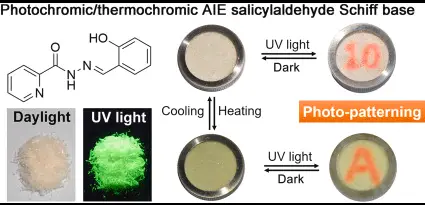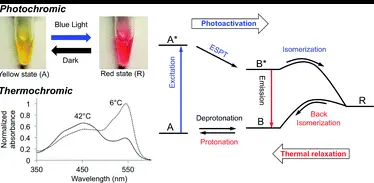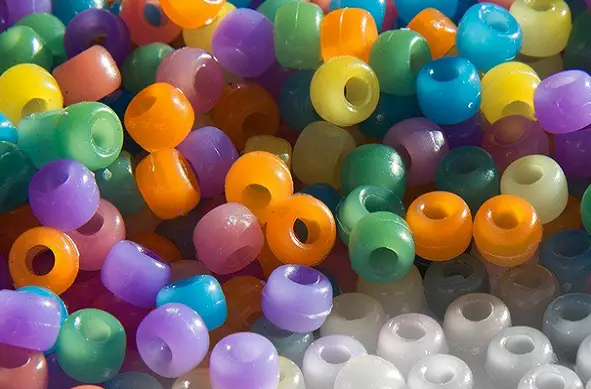Smart materials have revolutionized the way we interact with our environment, and among these, photochromic and thermochromic materials stand out for their unique properties and applications. Both technologies respond to changes in their surroundings, but they do so in markedly different ways. As technologies evolve, the distinctions between these materials become crucial in various applications from eyewear to textiles.
Photochromic materials change color based on light exposure, typically UV light, while thermochromic materials change their color in response to temperature changes. This fundamental difference highlights their unique applications and the specific environments in which they are most useful. For instance, photochromic lenses darken on sunny days and clear up indoors, whereas thermochromic materials might be used in mood rings or thermal indicators.
The relevance of photochromic and thermochromic materials extends beyond their fascinating color-changing abilities. Their integration into daily use products and industrial applications showcases their potential to enhance functionality and safety. These materials are not just novel party tricks; they are sophisticated responses to the demands of modern living, offering both adaptability and information through color changes.

Definitions and Basics
What is Photochromic?
Photochromic materials are substances that react to light—specifically ultraviolet (UV) light—by changing color. These changes are reversible, which means that when the light stimulus is removed, the material returns to its original state. A familiar example of this technology can be seen in eyeglasses that darken under bright sunlight and clear up indoors.
What is Thermochromic?
Thermochromic materials, on the other hand, respond to changes in temperature. They alter their color at specific temperatures, which can be tailored during their production. This characteristic makes them useful in a variety of settings, from fashion to safety, allowing them to serve as visual indicators of temperature changes.
Core Mechanisms
How Photochromic Materials Work
The magic behind photochromic materials lies in their molecular structure. These materials contain compounds such as silver halides or organic molecules that undergo a chemical process when exposed to UV light. This process alters their molecular structure in such a way that they absorb more light, thus appearing darker. The steps involved include:
- Activation: UV light hits the material, causing the molecules to change structure.
- Color Change: This structural change modifies the optical properties, darkening the material.
- Reversion: Once the UV light is removed, the molecules gradually return to their original form, and the material clears up.
How Thermochromic Materials Work
Thermochromic materials operate through a similar, yet distinct mechanism. These materials often incorporate leuco dyes, which are combined with chemical compounds that respond to temperature changes. The mechanism can be outlined as follows:
- Heat Exposure: As the temperature rises, the molecular structure of the dye changes.
- Color Transition: This change either creates a color or makes the dye colorless, depending on the temperature.
- Cool Down: When the temperature decreases, the original chemical structure and color are restored.
Key Differences
Response Triggers
The primary difference between photochromic and thermochromic materials is their triggers. Photochromic materials react to light levels, particularly UV light, while thermochromic materials respond to changes in temperature.
Material Composition
The composition of these materials also varies significantly. Photochromic materials often use silver chloride or silver halide crystals embedded in a glass or plastic matrix. In contrast, thermochromic materials typically use leuco dyes mixed with suitable developer chemicals and a solvent.
Application Areas
While both materials find applications in various industries, their distinct response mechanisms dictate specific uses. Photochromic materials are prevalent in vision-related applications, while thermochromic materials are often found in temperature monitoring systems.
Applications
Photochromic Applications
Eyewear and Vision
One of the most well-known applications of photochromic technology is in adaptive eyewear. These glasses:
- Adjust automatically to changing light conditions.
- Provide UV protection by darkening under bright sunlight.
- Offer the convenience of not switching between sunglasses and regular glasses.
Textiles
Photochromic textiles change color in the sun, making them appealing for fashion and recreational use. They can also be used in:
- Safety clothing, which changes color in sunlight to enhance visibility.
- UV exposure indicators, helping wearers manage sun exposure to prevent skin damage.
Data Storage
Advanced photochromic materials can be used in data storage technologies to store and erase data using light, which can significantly increase data security and integrity.
Thermochromic Applications
Mood Rings
Mood rings are a popular novelty item that uses thermochromic materials to reflect the wearer’s body temperature, which is often claimed to indicate mood.
Thermometers
Thermochromic materials are used in thermometers, especially in medical applications like forehead thermometers, where they indicate temperature changes visually.
Smart Packaging
In the packaging industry, thermochromic materials help in monitoring product temperatures, ensuring that items like perishable goods are kept within safe temperature ranges during transport.

Benefits and Limitations
Advantages of Photochromic
UV Protection
Photochromic lenses offer significant UV protection because they automatically darken in response to sunlight, which predominantly emits harmful UV rays. This automatic adjustment helps protect the eyes from potential UV damage, reducing the risk of cataracts and other eye health issues related to UV exposure. Users benefit from a single pair of glasses that serves dual purposes—clear vision indoors and protection from intense sunlight outdoors.
Energy Efficiency
Photochromic materials are also pivotal in enhancing energy efficiency in buildings. Windows coated with photochromic films can adjust their tint during different times of the day, which helps in maintaining optimal indoor temperatures without excessive reliance on air conditioning or heating systems. This adaptive shading technology minimizes energy consumption, leading to reduced electricity bills and a lower carbon footprint.
Advantages of Thermochromic
Temperature Sensing
Thermochromic materials are invaluable in temperature sensing applications. They provide immediate visual feedback on temperature changes, which is critical in various settings. For instance, thermochromic paint on a battery can show if it’s overheating, and similarly, thermochromic labels on food packaging ensure the consumer can see if the product has been stored at the correct temperature, thereby indicating its safety and freshness.
Safety Features
The safety features provided by thermochromic materials are especially important in products designed for vulnerable populations, such as children’s items and healthcare products. For example, baby spoons made with thermochromic materials change color if the food is too hot, and bath toys can indicate if the water is too warm for a child’s skin. These applications make it easy to prevent burns and injuries, enhancing safety through simple color changes.
Limitations of Both
Durability Concerns
One of the main limitations of both photochromic and thermochromic materials is their durability. Over time, the effectiveness of the color-changing properties can diminish, especially if the materials are frequently exposed to harsh conditions such as extreme sunlight, high temperatures, or corrosive chemicals. This degradation can lead to a shorter useful life than initially expected, which might be a significant drawback for long-term applications.
Cost Factors
Another considerable challenge is the cost associated with these technologies. The production of photochromic and thermochromic materials often involves complex chemical processes and high-quality raw materials, which can drive up the costs. Additionally, integrating these materials into products can require specialized manufacturing techniques, further increasing the expenses. These cost factors can make the end products relatively expensive, potentially limiting their market reach.
Market Trends
Current Market Overview
The market for smart materials, including photochromic and thermochromic materials, is currently experiencing significant growth. The increasing demand for adaptive eyewear and smart windows drives the market for photochromic technologies. At the same time, the need for improved safety and quality assurance in consumer goods supports the growth of thermochromic materials. As industries continue to recognize the benefits of these materials, their applications are expanding beyond niche markets into more mainstream sectors.
Future Projections
Looking ahead, the future projections for photochromic and thermochromic materials are overwhelmingly positive. Technological advancements are expected to address current limitations such as durability and cost. Researchers are actively working on new formulations and composites that could enhance the stability and reduce the production costs of these materials. Moreover, the trend towards more personalized and adaptive products is likely to boost the demand for these smart materials, as they offer significant advantages in terms of convenience, safety, and energy efficiency.
Frequently Asked Questions
How do photochromic materials work?
Photochromic materials contain molecules that change structure when exposed to ultraviolet light, causing them to absorb more light and appear darker. This reversible process allows materials like eyeglass lenses to adjust to changing light conditions automatically.
What are common uses of thermochromic materials?
Thermochromic materials are commonly used in mood rings, which change color based on the temperature of the wearer’s skin. They are also used in thermometers, baby spoons that change color when food is too hot, and in batteries to indicate overheating.
Can photochromic and thermochromic materials be used together?
Yes, combining photochromic and thermochromic technologies can enhance the functionality of a product. For example, eyewear that adjusts to both light and temperature changes can offer superior comfort and protection in varying environments.
Are these materials safe?
Both photochromic and thermochromic materials are generally considered safe for everyday use. However, as with any material, it is crucial to ensure that they do not contain harmful substances and are used in a way that complies with safety standards.
How long do these materials last?
The lifespan of photochromic and thermochromic materials can vary depending on the quality of the material and the conditions of use. Generally, with proper care, these materials can maintain their effectiveness for several years.
Conclusion
The intriguing world of smart materials such as photochromic and thermochromic technologies offers a glimpse into the future of material science where functionality and aesthetic appeal coexist seamlessly. As we continue to explore and refine these materials, their potential to improve not only consumer products but also industrial applications is boundless.
In summary, the distinction between photochromic and thermochromic materials is not just academic but practical, with significant implications for design and usability across a range of products and industries. Their ongoing development and increased integration into everyday items will likely continue to offer new solutions to old problems, making our interaction with the material world more intuitive and responsive.

